So far this fall it has been exceptionally warm, but things are about to change as a major cold front is expected by Thursday night. For those wondering where all the cold air has been, some of it is about to arrive as the coldest air so far this season invades North Texas. The cold air has been locked up on the other side of the globe across much of Russia and Europe. In parts of Russia, temperature departures have been running as much as 50 below normal. Global signals have been pointing to a northern hemispheric pattern change for about the last ten days or so and the beginning will be occurring later this week.
Until the cold air arrives, near record breaking heat will be possible, especially tomorrow where temperatures may sore into the mid and upper 80s for highs. As a strong upper storm system digs along the west coast, southwesterly flow aloft and southerly flow at the surface will help bring up Gulf moisture into the area beginning tomorrow into Thursday. As the storm system begins pushing out onto the Plains, height falls will overspread North Texas allowing the pressure gradient to tighten making for a very windy day Thursday with gusts up to 35 mph possible. A strong cold front will push southward on Thursday night. As it does so, an initial EML will give way some scattered showers and thunderstorm development along the boundary as it pushes through the area Thursday night into early Friday morning. Not everyone will get rain, and the further east one goes across the forecast area, the better the rain chances.
Behind the cold front, expect much cooler/colder air will invade the area. Friday will see the high temperatures probably earlier in the day with near steady to slowly falling temperatures throughout the day. Lows by Saturday morning will for sure fall into the 40s area wide and highs on Saturday will struggle to reach 60°F, even under full insolation. By Sunday morning, the high pressure cell will build directly overhead into North Texas allowing for clear skies and an excellent radiational cooling setup. Lows should drop into the 30s area wide with some of the colder spots reaching freezing. The first frost of the season looks like a good bet for much of the area on Sunday morning.


